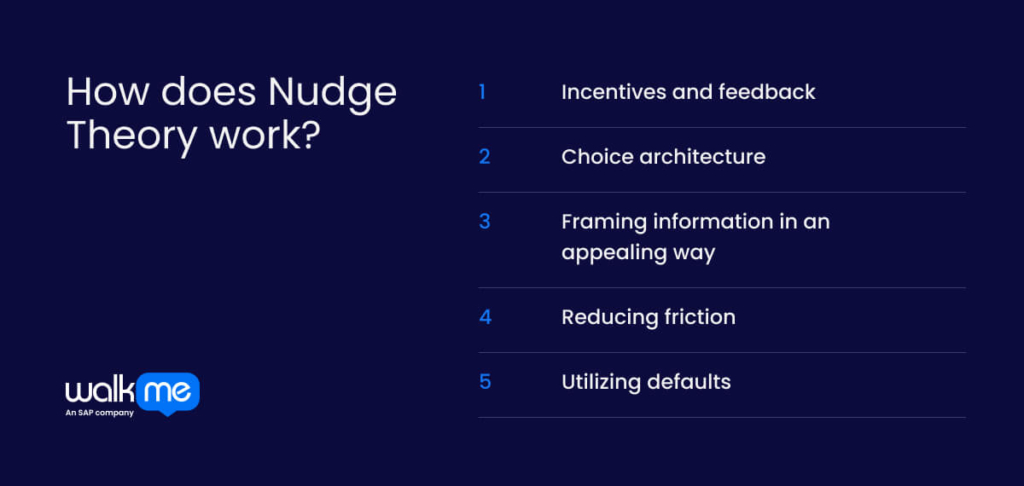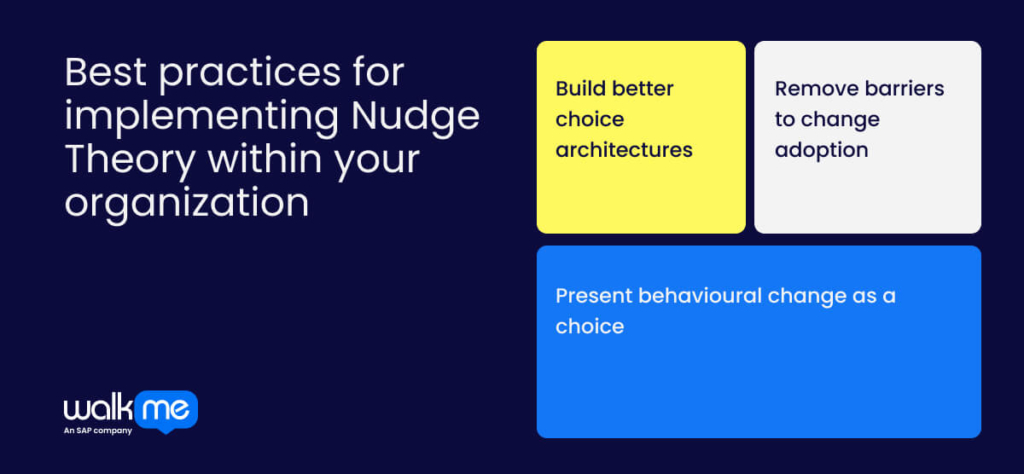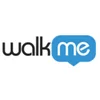Change is never easy—especially in the workplace. Too often, companies roll out new processes or technologies with rigid mandates. The result? Frustration, low morale, and resistance.
In fact, a recent Pew Research Center study found that 46% of employees would consider quitting if they were forced to return to the office full-time. That’s not just turnover—that’s a threat to your entire change management strategy.
When people feel pushed, they push back. But what if you could guide behavior without force—encouraging adoption instead of enforcing compliance? That’s where Nudge Theory comes in. By shaping choices rather than dictating them, leaders can facilitate digital transformation, enhance employee engagement, and accelerate the adoption of new digital systems.
In this article, we’ll explore what Nudge Theory is, why it matters in change management, and how to apply it with real-world examples and best practices.
What is Nudge Theory?
Nudge Theory is a concept that involves using small, gentle pushes to guide people toward better decisions. It acknowledges that we often rely on habits and mental shortcuts rather than engaging in deep thinking when making choices.
Instead of imposing strict rules, the Nudge Theory works by changing the environment in which decisions are made.
For example, using social proof or testimonials to highlight why someone should sign up for a product or a service is a nudge. This can be useful if your business is trying to roll out a new software product. It also uses our natural tendency to follow what others are doing. The goal is to use positive encouragement, not penalties, to influence behavior.
Nudges also always preserve our freedom to choose differently. By making the better option the most straightforward one, Nudge Theory helps people make positive changes on their own, without feeling pressured. It’s about making good choices feel effortless.
History of Nudge Theory
In the 1970s and 1980s, psychologists Daniel Kahneman and Amos Tversky studied how people often make decisions that don’t follow logical models. They introduced ideas such as Prospect Theory, which became a key component of behavioral economics.
Building on their work, Richard Thaler and Cass Sunstein introduced the concept of ‘nudging’. They did this through their 2008 book, Nudge: Improving Decisions about Health, Wealth, and Happiness. It explained libertarian paternalism, where small nudges guide people toward better choices without limiting their freedom of choice.
The book also introduced the concept of choice architecture, illustrating how the presentation of options can influence decisions. For example, it discussed how automatic enrollment in pension plans (opt-out systems) increased participation.
During this time, governments and businesses quickly adopted nudge theory to improve public policies, encourage sustainable choices, and influence behavior. For instance, in 2010, the UK established a ‘nudge unit’ called the Behavioural Insights Team to incorporate behavioural elements into policy. In 2017, Richard Thaler won the Nobel Prize for his work, highlighting its global impact.
How does Nudge Theory work?

Understanding Nudge Theory is important because it offers a gentle approach to guiding people’s choices. It helps create positive change without forcing them or limiting their freedom. This makes it useful in business, leading to better outcomes for companies.
Here are the various elements of its inner workings:
Incentives and feedback
Nudge Theory uses small, psychological incentives instead of large financial rewards. It uses gamification, such as streaks and the power of loss aversion to motivate action.
Feedback also acts as a nudge by making results clear. For instance, a fitness tracker can show you the daily steps you took on a day. Incentives provide the initial motivation, while feedback reinforces the behavior, helping you stick with new habits.
Choice architecture
Choice architecture can help a business design an environment to guide decisions without limiting freedom. It uses smart defaults, simplifies choices, and highlights social norms to influence behavior.
How options are framed and physically placed also nudges people toward better outcomes. This approach enables people to make informed choices without being forced or having their options restricted.
Framing information in an appealing way
Message framing guides choices by changing how information is presented, without limiting your freedom. It appeals to our emotions and mental shortcuts. For example, people are more motivated to avoid a loss than to achieve an equal gain.
For example, to encourage employees to complete enterprise-wide training, you could reframe the message. Instead of simply asking them to do it, say that completing the training on time increases their chances of getting a promotion. This emotional appeal nudges our decisions toward a desired outcome.
Reducing friction
By reducing friction through the Nudge theory, you make good choices easier. It works by creating easier processes and utilizing defaults, such as automatic retirement enrollment. Through lowering barriers such as effort and time, a nudge also prevents us from procrastinating in making a decision.
Utilizing defaults
Default nudges make choices easy by setting the desired option as the automatic one. People often stick with these pre-selected choices because they see them as recommendations, and changing them takes effort.
Opt-out systems, where you’re included unless you actively say no, are a powerful default option. Examples include retirement savings, where automatic enrollment leads to higher participation.
What are examples of Nudge Theory in practice?
Knowing how Nudge Theory works in the real world is essential. It helps you understand how to guide people’s choices in a positive way. By looking at real examples, you can learn how to use these ideas in the lives of your employees.
Here are the examples that you could explore at your organization or in specific industries:
Workplace examples
Nudge Theory helps workplaces encourage good behavior while still preserving the freedom of choice.
Here are some instances where you can use nudges:
Improving employee productivity
Nudge Theory can enhance employee productivity with minor changes. For example, put up posters with inspiring quotes or signs to encourage clean desks. You can also set meetings to last 25 minutes instead of 30. This gives people a short break to stretch and helps reduce meeting fatigue.
Enhancing compliance and safety
You can help people follow rules by making good choices easier and more appealing. For example, you can place printers farther away from workstations to promote movement. You can also use visual or sound reminders to encourage handwashing or other necessary actions at the right time.
Broader applications
It’s important to see how Nudge Theory works in specific industries. This shows us how it can be used in real and often complicated situations.
These are some examples of those situations:
Business and marketing
Businesses can use slight nudges to guide people’s choices. For example, they can add helpful features to apps that employees use daily to improve the future of learning. Marketing teams can also use the Nudge Theory by placing popular items at eye level or on a homepage to attract customers. Simplifying checkout steps also makes buying easier.
Public health
Leaders can improve public health by using nudges. For example, they can share that most people in the community are getting flu shots to encourage others to join. They can also highlight healthier food and drink options, including low-calorie choices, to guide better decisions.
Digital nudges
Digital nudges use digital tools, like apps and alerts, to help users do certain things. When these nudges are placed well, they can make users more involved and build their trust.
Here’s how you can use a digital nudge at your workplace:
In-app nudges
In-app nudges are prompts, such as tooltips, banners, or red dots, that guide users to take specific actions. They provide helpful and timely information without being annoying. Nudges appear at the right moment, based on the user’s current activity.
For example, an employee might see a red dot for a feature they haven’t tried. Companies can also use nudges to share tips or improve performance.
Reminder campaigns
Workplace reminder campaigns employ various methods to keep employees informed about tasks and essential details. For example, you can send a series of short, engaging emails about benefits, including medical plans or retirement options. You can also automate emails before deadlines using a fun subject line like, ‘Make Friday ‘Friyay’ with a completed timesheet!’
Best practices for implementing Nudge Theory within your organization

Following best practices is crucial when applying Nudge Theory within your organization. It ensures your efforts are fair and create changes that actually last.
When you have a clear plan, employees are more likely to accept new ideas and initiatives. This leads to much better, long-term results than just trying random things to change behavior.
Choose these best practices when adopting the Nudge Theory methodology:
Present behavioural change as a choice
Want to help people make better choices? Make the best option the easiest one. For example, you can set the healthiest choice as the default. People can still pick something else, but the easy path leads to a good decision. Simple reminders also work well, such as a sign that says, ‘Take a break and hydrate!’
Showing that other employees are already doing it well also works wonders. We like to feel like we’re part of the group. The most important rule is to never force anyone. The choice is always theirs. You’re gently pointing them in a better direction.
Remove barriers to change adoption
To encourage change, start by understanding what’s stopping employees and consider their perspective. Make the desired action easier by reducing barriers. For instance, if you want them to use a new system, organize employee training before the rollout.
Use visual cues and show how others are already adopting the behavior. Provide timely reminders, celebrate small successes, and lead by example. Always ensure people have the freedom to choose and focus on improving their well-being.
Build better choice architectures
To encourage a preferred decision, you need employees to choose this one over all of the others. You can make the best option the automatic choice, as most people will stick with the easy path. Offering rewards, such as money or a sense of accomplishment, can also motivate good behavior.
When decisions are complex, simplify them into easy steps to avoid confusion. You can also make the right choice stand out by making it more obvious. For instance, if you need to encourage everyone to come into the office on a designated day, offer a free breakfast.
Make enterprise change management easier by applying the Nudge Theory
Nudge Theory helps IT leaders and software teams manage change more effectively. Instead of forcing people, it uses small, innovative suggestions to guide them toward using new software.
To implement it, you can make the new system the default choice or send timely reminders. A digital adoption platform is an excellent tool for this, as it can deliver in-app nudges, such as pop-up tips and guided walkthroughs, right when users need them.
This type of approach reduces resistance and makes it easier for everyone to adapt. It also makes difficult transitions easier and allows you to improve your technology adoption process in the future.
FAQs
Nudge Theory is a simple and low-cost way to help people make better choices and improve their behavior. It can lead to higher productivity, greater well-being and smarter use of resources. By using insights from human psychology and cognitive biases, nudges can be added to policies and designs to make good actions easier.
Nudge Theory faces challenges, including ethical concerns about manipulation and the erosion of freedom of choice. It may not work well for deep habits or big changes and often depends on the situation. Research can be biased or flawed, and nudges might fail or cause opposite effects.
Nudge Theory guides workplace behavior by making desired actions simple, visible and the default. Examples include safety reminders, easier stair access, well-placed common areas, and default sign-ups for wellness programs, all while allowing employees to opt out.

